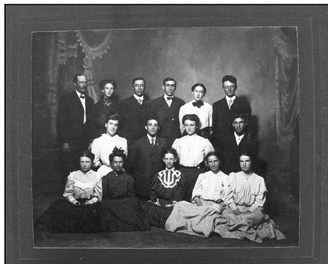Loyal’s little moments preserved in museum


by Dean Lesar
History is usually recorded over long stretches of time — 150 years now in the city of Loyal’s existence, for example — but what is that history except for countless ordinary moments strung together and interrupted by a few brief flashes of unforgettable events? To tell the full story of Loyal’s 150 years is a mostly impossible task now, as we are left with only a minimal number of written words to cover a large swath of years during which none of us alive in 2020 were here to witness. One can’t ask the old-timer anymore, “So what was it like in 1895?” or “How many Loyal young men went off to fight in World War I?” If nobody wrote it down, it’s gone.
Luckily for Loyal, it has a historical society, which has a museum, in which to collect mementos of the city’s bygone days. Without such a place, a community’s past can be scattered with the wind, as photo albums, pieces of memorabilia, diaries, etc. get tossed one by one unless there’s a location in which they can be amassed and stored. History can be as compelling as a 90-year-old grainy black and white photo of the aftermath of a momentous downtown fire, or as personal as someone’s great-grandparents’ family wedding portrait.
The Loyal Area Historical Society museum on East Elm Drive includes three buildings, each housing a varied set of city artifacts. The Society bought the site and one of the buildings itself, and accepted the generous donation of the other two structures from the Irban Aumann family. Aumann’s service station replica building and railroad station depot contain much of the history the Aumann family amassed, plus more that the Historical Society has been adding through time from local donations.
One won’t find the complete, chronological account of Loyal’s first 150 years in the museum, or anywhere else for that matter. An attempt to write the community’s first century story was made in 1970, when the city celebrated its centennial, but no “history book” of sorts has since been produced to chronicle the full 150 years since the city’s founders had the first few streets platted. As any length of time in history grows, the task of telling it all becomes more difficult. It can be found, though, in small, singular pieces that when collected all together tell the full story. It’s not of great importance, for example, that the Loyal Modern Woodmen of America Camp #1414 decided in late October of 1899 to buy the Loyal Opera House. But there it is, hand-written in pencil, in the camp’s “Blotter for Rough Minutes” that has been preserved at the museum “Neighbor Marsh,” those minutes read, “moved that the camp offer $1,150.00 for the hall and all paraphernalia included, at 6 percent per annum, with a payment of $100 down. Motion seconded by Neighbor Mengel. Motion put and carried.”
Those “neighbors” of Modern Woodmen of America Camp #1414 had no idea on that evening on Oct. 28, 1899, that the action they took would be recalled some 121 years later as a future community commemorated its 150th year. They made history in a small way that night, and in recording it — and someone else preserving it — added it to the collective memory of Loyal. What use the camp ever made of the Opera Hall, how long it owned it, when it may have been torn down, is likely all lost to history, as are thousands of other such moments.
It doesn’t matter, either in the grand scale of Loyal’s history, that guests at Loyal’s Hotel Weaver on the 19th day of August of Year of our Lord 1892 included J.B. Kandy of Colby, Joe Fisher of Fairchild, and Harry Killburn of Stevens Point, yet there are their signatures on the hotel registry on display in the museum. The Hotel Weaver had a “livery in connection” and a “sample room for commercial men” and must have been a popular place in its day, as each page of the hand-written daily registry carries the names of a dozen or more guests.
One can surmise from other known history of Loyal that they had perhaps arrived by train, and may have been here to do business in the local logging trade, or perhaps to speculate on land for a small dairy farm like those that were beginning to appear on the cut-over acreage. Loyal proper had been a budding town for about 22 years at this point in time, the rough plat drawn in 1870 (which is recognized as the date of origin of the town) directing where dirt streets would be and the buildings constructed along them. Blacksmith shops, stables, general stores, butcher shops, and taverns were among those first establishments of Loyal.
So, too, a school eventually came along, with Loyal High graduating its first students in 1897. As more people moved to the area for farmland, or to join relatives who had begun to stake a claim here, more children arrived. Education they must have, the community decided, and organized a public school. Early records exist of those first classes, such as the daily attendance logs of the 1909-10 school year that show that one Lillian Miles made it to class 169 days and missed only once. The rooster at Mac Halls’ farm must have been delinquent, as he made it to school 168 days, but was late on 33
Please see Museum, page 10
Nameless faces of Loyal’s past abound in photographs at the Loyal Area Historical Society museum. This undated photo identifies only that Ray Prior is in the center of the group. Museum,
from page 3
of them. Blanche Derby may have contracted one of the many illnesses of the day, as her school attendance record showed 111 days present and 44 absent. Alfred Kreiser may have had to stay home and help with the chores, as he missed 31 days and was tardy another 22.
Loyal finally incorporated into a village in 1893, two years behind its neighbor to the west, Greenwood. Greenwood had been so named for the lushness of the area forests when the first settlers arrived there, and thousands of those virgin growth logs were floated southward down the Black River to the growing mills of the region. The Loyal-area was also logged bare of its virgin growth, and its logs also taken to the Black for transport in high water.
Loyal did not derive its name from any natural resource or distinctive physical feature, but from the patriotism of its young men. As popular folklore goes, Loyal was so-named because so many of its men marched east and south during the Civil War to fight for the Union cause. Such loyalty has been a distinction of the community since, the museum preserving this status with such objects as the old “in memoriam” ribbon for Col. C.R. Gill of Post #206 displayed a few feet from a plaque commemorating the sacrifice of National Guardsman Todd Olson, lost in the Middle East in 2004.
Through World War I and the Great Depression Loyal persevered. The community settled on agriculture as its main industry, the hundreds of families who settled on the fertile lands plowing up thousands of acres on which to graze cattle and grow crops to carry them through the winter. Loyal’s museum tells those stories, too, with pieces of old equipment, the first milking machines, a blacksmith forge, an oats cleaner, a corn sheller, yokes, scythes and so forth.
As the rural area around the village (which then became a city in 1943) grew, so did the small town. Businesses serving the farmers were numerous and varied. First those that catered to the horse teams prospered, then those disappeared as gas engine tractors took over the land. More stores were needed to supply the population in a day when Neillsville or Marshfield were just too far away to visit often.
The collection of business memorabilia in the museum tells of the variety of businesses that Loyal’s downtown hosted through the years. Each of those businesses traditionally gave patrons a gift at holiday time, like the pen holder offered by North Star Cheese. Hill Funeral Home & Furniture gave out yardsticks, Braun’s Bar and Bowling a coin purse. There was a cup from Ditter Well Drilling, a piggy bank from Witt’s Meat Market, an ash tray from Seeman Gas & Oil, a spatula from the Loyal Skogmos Store, a deck of cards from Bob’s Electric, a calendar plate from the Loyal State Bank, a thermometer from Beaver Dry Goods, and a tape measure from Jeanette’s Fashions.
